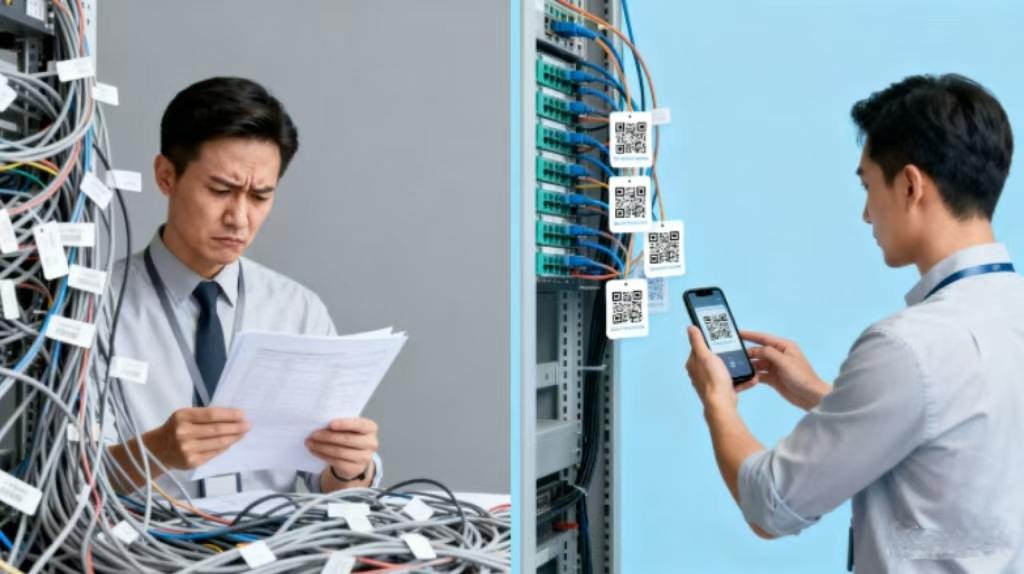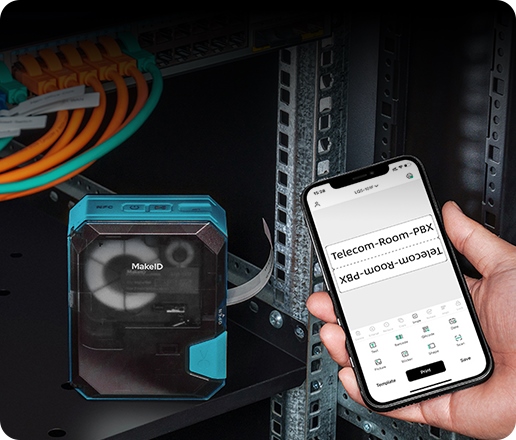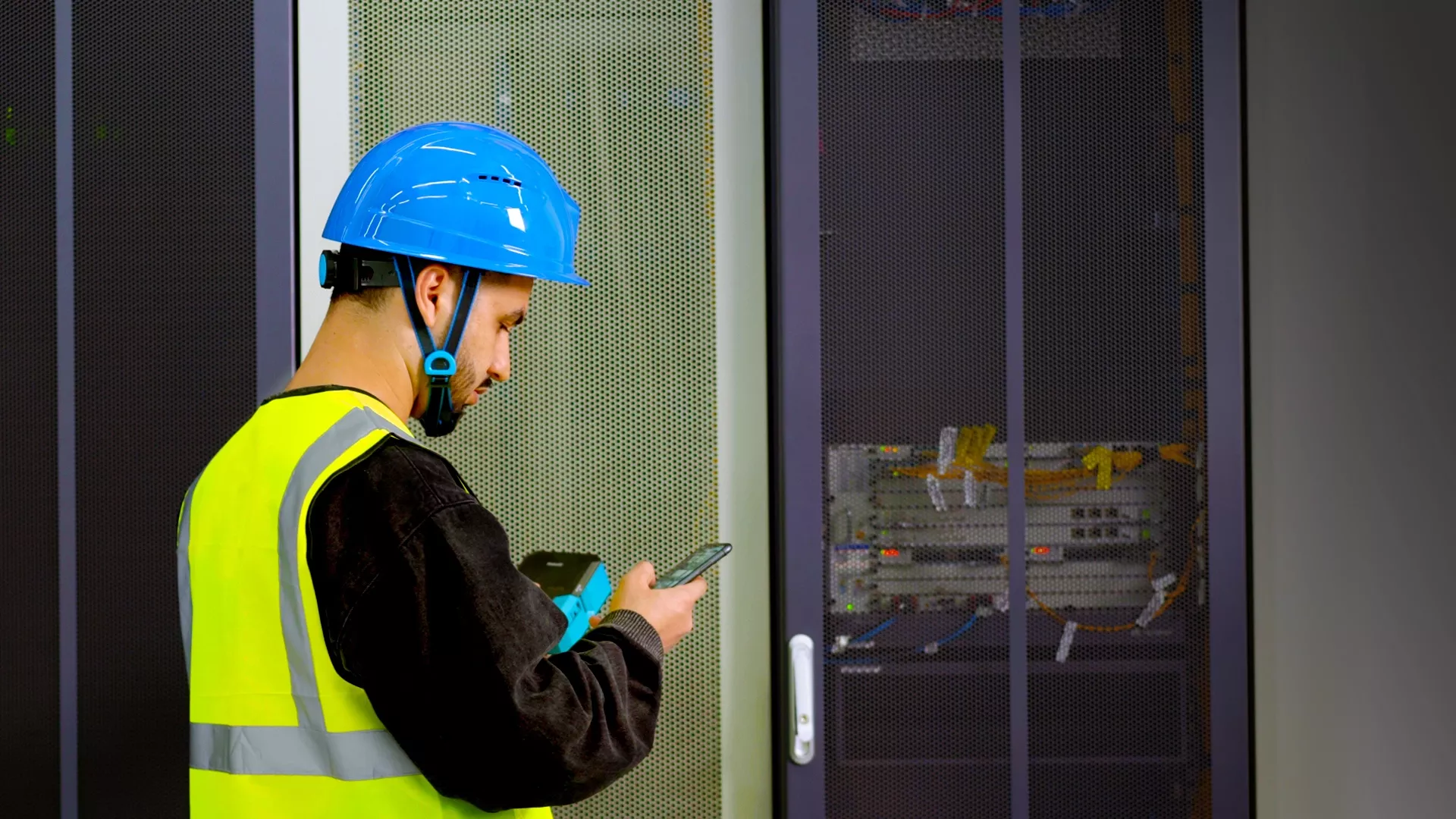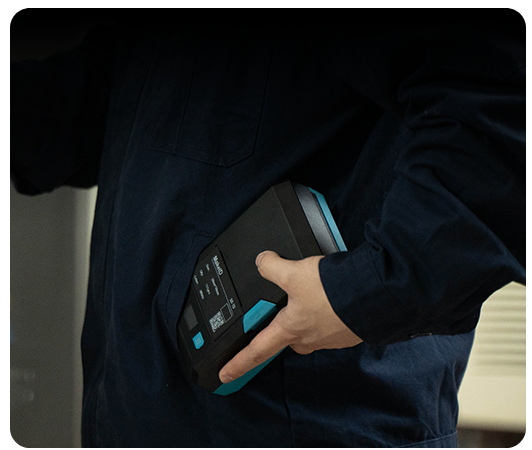How Can Cable Identification Labels Speed Up Inspections?
In telecom, optical cables are the “lifeline” for network signal transmission and stable operation, and optical cable inspection is key to protecting this lifeline. Regular checks are needed for dense indoor wiring, remote base station cables, and underground lines to spot hazards and prevent failures.
Yet, with hundreds of crisscrossed, unlabeled optical cables, inspectors waste most time on locating, checking records, and handwritten notes—slowing hazard detection and cutting effective inspection time, affecting network service quality and user experience.
To address this, MakeID proposes the Digital Management of Telecommunication Resources Identification Solution. By combining high-durability optical cable identification labels, professional label printers, big data analysis and GIS visualization, it realizes full-lifecycle digital management of on-site equipment assets and telecom resources. This fundamentally shortens inspection time for on-site inspectors, making telecom optical cable inspections more efficient and accurate.

How Optical Cable ID Labels Solve 3 Major Inspection Challenges
Cable identification labels significantly cut inspection time by solving three core inspection problems: “difficult line positioning”, “delayed label updates” and “inefficient information verification”. Meanwhile, label printers provide key support for high-quality, efficient label production, and the two work together to form a complete efficiency-enhancing chain.
1. Quick Identification
Locating target cables among large quantities is one of the most time-consuming inspection tasks. High-quality cable identification labels let inspectors lock onto targets instantly, as they clearly include key details like cable ID, start/end points, specifications, installation time, and maintenance cycles—eliminating time-consuming sorting and repeated confirmation.Label printers are crucial for ensuring “clear and legible” labels. Thermal transfer printers make text adhere firmly to materials, remaining clear in harsh conditions (e.g., high temperatures in computer rooms, outdoor rain, dust). Thermal printers, a more cost-effective option for short-term use, also ensure readability. Additionally, stain-resistant and anti-aging label materials compatible with printers extend readability, fundamentally reducing ineffective search time.
2. On-Site Production
During inspections, old labels often fall off or wear out, and new temporary cables lack labels. Without on-site tools, inspectors must record issues, return to the office to make labels, and revisit the site—wasting time and potentially delaying fault handling.Label printers solve this: portable models (compact, Bluetooth-enabled) print waterproof, UV-resistant labels on-site in minutes for outdoor use. Desktop printers enable batch production, cutting the time to make labels for hundreds of cables from 3 days to 1 day. Both options enable “on-demand and immediate” label making, avoiding time-consuming round trips.

3. Standardization and Digitization
With the telecommunications industry’s digital transformation, inspection work is shifting from “paper records + manual verification” to digital management. High-quality cable identification labels need digital features (e.g., QR code or RFID chip integration); scanning allows inspectors to access cables’ full lifecycle data (historical faults, maintenance time, responsible personnel), eliminating heavy paper records and reducing repeated verification time.Label printers are key to this digital function: models supporting QR code printing ensure clear, easily scannable codes, while high-end ones enable RFID tag writing to input cable info directly for quick reading via inspection terminals. Printers’ intelligent labels link cable info to digital inspection systems, breaking free from inefficient manual verification and further cutting verification time.
Label Printers’ Value in Inspection Scenarios
Telecommunications cable inspection involves diverse scenarios with unique environmental traits and needs, and label printers drive notable efficiency gains across them.
Dense Wiring in Computer Rooms
As telecom hubs, computer rooms have massive intertwined cables. Traditional handwritten labels are time-consuming, blurry, and incomplete, slowing later inspections due to tedious cable sorting.
With suitable label printers, technicians preset templates, batch-print high-temperature-resistant labels, and paste them per wiring diagrams. Batch production is far more efficient than handwritten labels. Clear labels cut target cable location time, boost overall inspection efficiency, and avoid misoperations from unclear labels.

Outdoor Base Stations and Pipelines
Outdoor and underground cables face harsh conditions, causing labels to age or fall off. Faults lead to blind inspections—wasting time, wasting resources, and disrupting services.
Portable label printers are ideal: they have strong protection for outdoor use, support wireless connections, and let inspectors edit/print waterproof labels on-site. Clear labels speed up fault location, slashing detection/repair time and improving emergency response.

Cross-Regional Inspections
In cross-regional inspections, inconsistent label styles/formats across teams cause confusion and extra communication, hurting efficiency and risking omissions/misjudgments.
Unified label printers with preset templates standardize colors and formats. This eliminates extra communication during collaboration, shortens handover time, cuts costs, and avoids issues from inconsistent labels.
Guide to Label Printer Selection for Telecom Inspection Scenarios
Selecting label printers suitable for telecommunications inspection scenarios is crucial to leveraging their efficiency-improving role. Different scenarios have significant differences in the type, function, and performance requirements of printers, so it is necessary to consider two dimensions—scenario needs and core functions—to ensure accurate selection.
Selection by Scenario
Batch Production in Computer Rooms: Priority should be given to desktop label printers. The core need of this scenario is batch and efficient label production, so key attention should be paid to the printer’s speed (models with ≥100mm/s are recommended), continuous printing capability (supporting large paper rolls to reduce paper change frequency), and compatibility with high-temperature-resistant label materials to meet the label needs in the high-temperature environment of computer rooms.
Outdoor Mobile Inspections: Portable label printers are a must. The outdoor environment is complex, so focus on the printer’s battery life (capable of printing at least 500 labels on a single charge), protection level (IP54 or above is recommended for water and dust resistance), and wireless connection function (supporting Bluetooth or Wi-Fi for on-site editing via mobile apps) to ensure stable use in field environments.
Selection by Function
Printing Technology: Thermal transfer printers are preferred. Thermal transfer technology transfers text to labels via ribbons, resulting in more durable and friction-resistant text, and is compatible with a wide range of label materials (from high-temperature-resistant to waterproof), meeting the needs of various scenarios in the telecommunications industry. For short-term temporary labels, thermal printers can be chosen for lower cost, though their text durability is relatively weaker.
Compatibility: Ensure the printer supports label materials and functions commonly used in the telecommunications industry. In terms of materials, it should be compatible with high-temperature-resistant, waterproof, and general-purpose labels. In terms of functions, it should support QR code printing, and for digital inspection needs, models compatible with RFID tag writing should be selected to ensure connection with operation and maintenance systems.
Usability: Choose printers that are simple to operate and easy to learn. Telecommunications inspectors have relatively high mobility, so printers should be equipped with intuitive operation screens and support label template editing via both mobile phones and computers. This reduces personnel training time and ensures both new and experienced employees can master the operation quickly.
Conclusion
In telecom cable inspections, cable identification labels are the “basic carrier” for cutting inspection time, and scenario-specific label printers are the “key engine” to unlock their value. Together, they solve three core pain points—difficult line positioning, delayed label updates, and inefficient information verification—via quick identification, on-site production, standardization and digitization.This significantly boosts inspection efficiency and reliability while optimizing the entire inspection process.
For printer selection or digital system connection support for communication inspection, click MakeID for customized solutions to boost inspection efficiency.on of the network.


